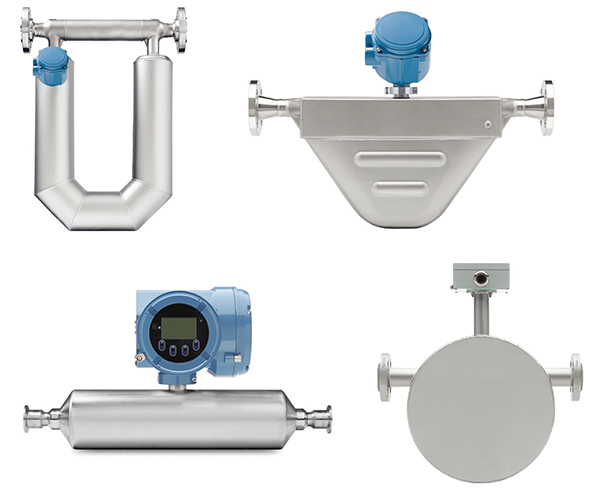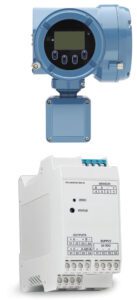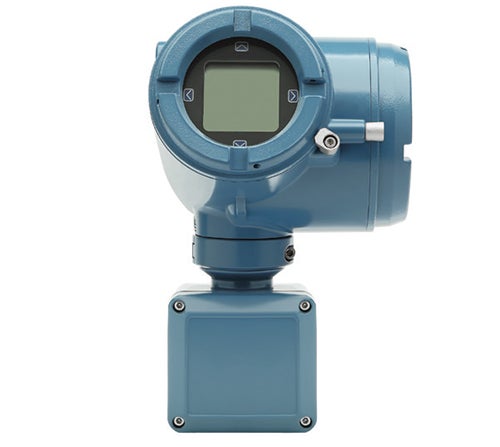Coriolis mass flowmeters are available with a range of body styles and transmitters, enabling significant functionality improvements without sensor replacement
Coriolis meters have long been a mainstay in the chemical process industries (CPI), providing highly accurate mass-flow measurements for raw-material charges, combustion control feeds and countless other process flows. These meters also measure both density and temperature, allowing them to be used for reactor split detection, and to measure inferred variables, such as acid or base concentration, oil-water ratios and many others.
New designs extend the capability of these types of meters significantly by enabling the upgrade of existing Coriolis transmitters to take advantage of new hardware, software and diagnostic features — without the need to replace legacy Coriolis sensors.
Most flowmeters cannot measure mass directly, but instead measure fluid velocity and use the pipe diameter to calculate volumetric flow. They then use assumed constants to convert that volumetric flow to a mass-flow equivalent. This provides an acceptable level of accuracy in some applications, provided that fluid density and temperature remain constant and match the values used in the calculation. Unfortunately, process conditions in many CPI applications tend to vary considerably, creating errors. However, Coriolis meters provide a solution to these and other flow measurement issues.
Coriolis meter advantages
Coriolis meters are one of the few flowmeter types that can directly measure the mass flow of either gases, liquids or slurries. They also simultaneously directly measure density and temperature, providing three vitally important measurements within a single meter. Most importantly, the mass-flow measurement remains accurate despite process variation, allowing production units to consistently close the loop on process mass balances and optimize production. Coriolis is also generally the technology of choice for raw-material charges and final-product flow measurement.
Highly accurate flow, density and temperature readings also allow Coriolis meters to make inference measurements — such as combustion-fuel quality, concentrations of acids and caustics and final-product quality or mixture ratios. These very robust measurements can be used as control points to replace expensive analyzer-based measurement units, which often require frequent maintenance.
But like every instrument, Coriolis meters do have their limitations. Historically, the sensors have tended to be large and expensive. The transmitter offerings were generally limited and rather costly as well, often offering area classifications and a multitude of inputs and outputs (I/Os) that are not necessary for many applications. Fortunately, these issues are being addressed with a host of revised sensor and transmitter designs.
Coriolis sensor options
There are now a range of Coriolis sensors designed to work well in a variety of processes (Figure 1). Typical applications use the basic U-tube type design (upper left image in Figure 1), with various form factors. Very high accuracy requirements necessitate the use of a larger U-tube to maximize signal-to-noise ratio, however, more compact designs are now available. These designs remain accurate, but have a smaller piping take-out and much reduced body size, made possible in part by a V-shaped tube. Beyond those sensors, there are many other options, including: straight-through, single-tube sensors that reduce plugging and can be pigged; all-tantalum body designs for corrosive liquids; and specialty meters designed for compressed or liquefied natural gas (CNG and LNG), hygienic applications; and designs for very high pressures up to 15,000 psi.

FIGURE 1. Advances in instrument design are enabling new applications for Coriolis meters
Sensor cost will vary considerably depending upon the body type, but the broad range of available options allows a user to find a suitable sensor to meet their specific application requirements and budget.
Transmitter improvements
There have also been significant technological advances in Coriolis transmitters, including new hardware capabilities and software enhancements. Historically, Coriolis transmitters had somewhat limited options, with only full-featured and expensive models available. To address varying needs, a range of Coriolis transmitters are now offered that include different electric classifications and I/O offerings, with enhancements that can be added as needed. This scalability of features allows users to choose a transmitter that meets their requirements without paying for unneeded or redundant features.
For instance, a typical high-tier Coriolis transmitter might carry Class 1, Div. 1 electrical classifications and have a large number of fixed I/O channels. Less expensive transmitters are now available for Class 1, Div. 2 or unrated electrical areas, and the I/O offerings have a smaller number of configurable channels to suit specific needs. There are also different housings available — such as standard painted aluminum or 316 stainless steel — to handle various process environments, and most of the transmitters can either be integral to the sensor or remote-mounted (Figure 2).

FIGURE 2. Coriolis transmitters are now offered with a wide range of housings, classifications and hardware offerings
New transmitters offer expanded hardware features that vary by model, but typically include options to energize the unit with a.c., d.c., two-wire power, or Power over Ethernet. Bluetooth access is another valuable feature offered with some models, as well as other connectivity options, including Modbus RTU, Modbus TCP, HART RS-485 or EtherNet/IP. Some units now offer configurable I/O, which allow specific channels to be set up for HART analog, frequency, digital inputs, digital outputs or various other digital communication options.
Many of the latest Coriolis transmitters can be configured without opening the cover using WirelessHART, secure Bluetooth connectivity or capacitance touch sensors on the graphical display. Most models also offer a USB port for fast configuration download or backup, and several Coriolis transmitters on the market are certified for use in areas rated with a safety integrity level (SIL) 2/3.
Coriolis software enhancements
Transformational advancements have been introduced in the software that operates within the Coriolis transmitter. There are now a broad range of enhanced capabilities offered as individually licensable options. Some of the new features include:
- Smart meter verification that can continuously monitor key performance indicators, like tube stiffness in Coriolis meters, to maintain measurement accuracy and meter integrity, thus driving cost reduction through early detection of issues
- Advanced phase measurement, which can detect and measure liquid and gas flow in multiphase applications, such as wellhead or oil-separator applications
- Petroleum measurement and American Petroleum Institute (API) correction software for API gravity and reference temperature and pressure compensation
- Net-oil computer calculations
- Concentration measurement software to calculate various measurements of dissolved solids, as well as specific gravity and other concentration measurements
- Piecewise linearization for enhanced gas applications
- Data historian with a real-time embedded clock
- Time-stamped digital audit trails and reports for agency compliance
- Most of these software features are available as options that are specified when the transmitter is purchased. If a particular software feature is required after installation, it can be purchased and added later.
Legacy upgrades
One significant advancement is the introduction of new Coriolis transmitters that have been specifically designed for retrofit onto legacy sensors (Figure 3). These units allow the user to keep their installed sensor in place, and simply replace the transmitter to take full advantage of new hardware and software enhancements. Transmitter replacement involves only a few simple steps and can be completed without breaking process lines or making any pipe modifications. Once replaced, the new transmitter provides access to the advanced diagnostics, broad connectivity options and process calculations currently available in the latest Coriolis meters.

FIGURE 3. Some Coriolis transmitters have been specifically designed to interface with a wide variety of legacy Coriolis sensors, allowing existing sensors to take full advantage of enhanced connectivity and software capabilities
For users with existing Coriolis meters, there are now transmitter upgrade options that allow the facility to take advantage of the latest diagnostics and advanced calculations, without incurring the downtime and expense of sensor replacement.
If faced with the need to specify a new Coriolis flowmeter or upgrade an existing sensor, users should fully understand the assortment of sensor and transmitter options that have recently become available. Coriolis meters have always been a premier flow-measurement device, but the latest technological advances make these meters even more capable and affordable. ■ Edited by Mary Page Bailey
Acknowledgement
All figures courtesy of Emerson
Author
 Brett Sibel is a Coriolis electronics and software product manager at Emerson (Email: brett.sibel@emerson.com). Prior to joining Emerson, he worked as a product engineer and product manager in various industries, including electronics, biomedical design and automation solutions. Sibel holds an M.S. degree in mechanical engineering from the University of Colorado at Boulder, and he is currently pursuing a Master of Business Administration degree from the University of Colorado at Denver.
Brett Sibel is a Coriolis electronics and software product manager at Emerson (Email: brett.sibel@emerson.com). Prior to joining Emerson, he worked as a product engineer and product manager in various industries, including electronics, biomedical design and automation solutions. Sibel holds an M.S. degree in mechanical engineering from the University of Colorado at Boulder, and he is currently pursuing a Master of Business Administration degree from the University of Colorado at Denver.